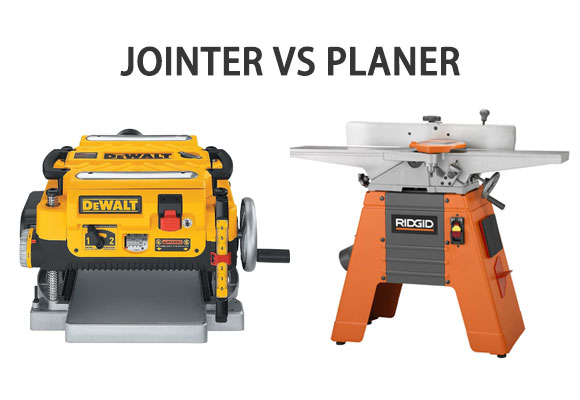
Jointer vs. Planer: Which One to Buy First?
In woodworking projects, flatness and uniformity of wood boards are of vital importance. By planing, rough-cut timber is turned into S4S (surfaced four sides) boards, ensuring the smooth running of the project. Then, here comes the question: a jointer vs. a planer, which tool should we use to create an S4S wood board? Though they appear to operate in a similar way, they have their unique role. Usually, a jointer and a planer go together to create a flat and consistent wood board. In this article, we’re going to focus on this topic: jointer vs. planer, explaining the differences between a jointer and a planer. In addition, if your budget can’t handle both of them, follow our guide to decide which one you should choose for your next woodworking project. We’ll start with the definition.

What is a jointer?
When it comes to creating a flat and smooth surface on a wood board, a jointer should be used. A jointer, also called a planer in the United Kingdom, is used for preparing wood boards in projects like furniture, cabinetry, and flooring. A jointer mainly consists of an infeed table, an outfeed table, a fence, a guard, and a cutter head. A rotating cutter head with several cutting blades is mounted on the jointer table to finish the flattening work. When the wood piece is passed over the infeed table and the outfeed table, the cutter head removes a little amount of wood material from the contact surface of the wood board. As a result, the surface becomes flat. In addition, we can also use a jointer to create a straight edge on a wood board.

(ridgid.com)
What is a planer?
Similar to a jointer, a planer is also applied to prepare wood boards for use in furniture, flooring, and other woodworking projects. A planer, also known as a thickness planer or a thicknesser, is particularly designed to trim a rough board to a specific thickness. The purpose of using a planer is to create a board of consistent thickness or make a board thinner. After one side of the board is flattened by a jointer, the other side can be smoothed by a planer to create a parallel face. A planer mainly comprises a cutter head with two or more planer blades, a flat surface called a bed, an infeed table, and an outfeed table. As the wood board is fed through the planer, the cutter head removes shavings of wood to produce a uniform thickness.

(dewalt.com)
Jointer vs. Planer: what are the differences?
As we mentioned earlier, both jointers and planers are used to prepare boards for woodworking projects. Their functions can be a little confusing. However, they are actually designed for different jobs. Here are the differences between a jointer and a planer.
- The cutterhead of a jointer is mounted underneath the wood board, whereas the planer’s cutterhead is mounted above the board.
- One of the main distinctions is that a jointer flattens one face of a workpiece, while a planer smooths the opposite face of the workpiece and makes it parallel to the first, creating a uniform thickness.
- A jointer is capable of removing twists, warping, and cupping, but a planer isn’t able to remove these flaws.
- A jointer can create square sides in a wood piece, whereas a planer can only ensure that the faces are parallel.
Using a jointer and a planer together
As we can see from the above, both a jointer and a planer have their advantages and disadvantages. To get the best results, it’s highly recommended to use them together.
- Use a jointer to produce a flat surface and a flat edge that is forming a 90-degree angle.
- Next, feed the workpiece into the planer with the smoothed side facing downwards to create two parallel flat surfaces and achieve a consistent uniform.
- Finally, when the faces and edges are prepared, we can use other woodworking tools such as a table saw for the further process.
Jointer vs. planer: which one to buy first?
To get the best working results, both a jointer and a planer are needed. However, if you can’t afford both of them at a time and decide to purchase only one machine, there are several factors to consider. Make sure that you are happy that you are getting value for money. Which one is more valuable for your woodworking project? If most part of your job is to smooth one board face or square the edge, a jointer is your first choice. While for a user whose job is to create flat and parallel surfaces, the ideal option is a planer. Therefore, get to know these two machines first and then select the proper one for your job.
What is a jointer-planer combo?
As the name suggests, a jointer-planer combo is the combination of the jointer and the planer. It has one cutter head to achieve two functions: jointing and planing. A jointer-planer combo is absolutely a convenient and space-saving option for small workshops or DIYers who don’t have room for separate jointer and planer machines. In addition, a jointer-planer combo can also reduce the necessity to move workpieces between different machines. Usually, the jointer section is placed on top with the planer underneath. We can switch between the two functions by adjusting the settings.
Final thoughts
Jointer vs. Planer is a frequently discussed topic for woodworkers and DIYers. They offer consistency, convenience, and speed, making them essential tools for woodworking. If your budget is adequate, we highly recommend that you should purchase both of them for a satisfactory woodworking result. However, if your budget is limited, you can choose one machine according to your project requirements. Don’t forget the jointer-planer combo!